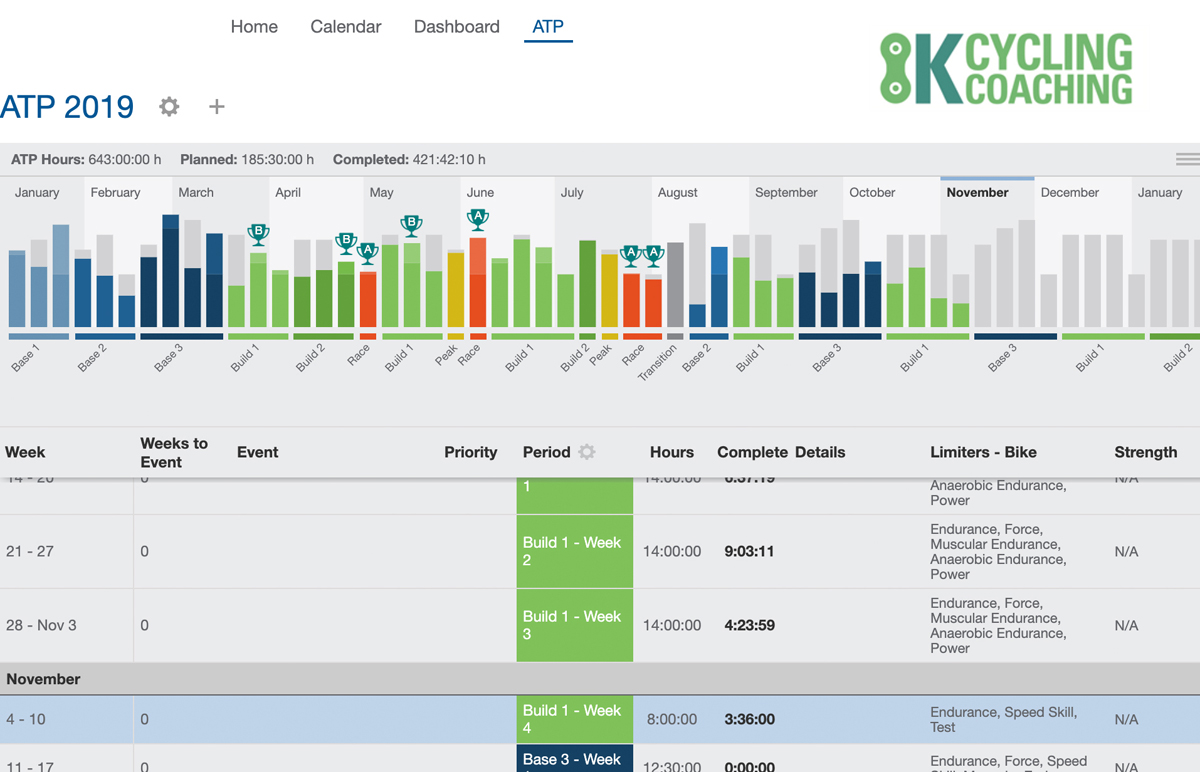Winter is here and many riders are hanging up their bikes. As your riding time comes down, it is a great time to start outlining and planning your next year of riding, training, and racing. What are the goal events or races you would like to target with your best fitness for next year? How can you map out a training plan to peak your fitness for these events?

You can start this process by picking one to three goal or ‘A’ priority events where you want to have your best fitness. I know, we all want to have our best fitness for every event. I wish we could. Of those one to three events, make one of those the A+, super priority. These may be races, charity rides, destination vacations, or anything else. Whatever specific times during the season you want your best cycling fitness. From those A events, you will work backwards to time your best fitness to line up with your highest priority goals. Ideally, you will have about 24-28 weeks to develop your fitness. More time can be better but 24-28 weeks is great.
As you work backwards from your event, plan about 12 weeks for base building, or general aerobic conditioning. Try to plan 16-20 weeks if you are new to endurance sports or a new rider. After a base building period, plan 12-16 weeks of more specific training to your event. This will generally include some higher intensity work and training that will more closely mimic the demands of your particular event. Even if your goal event is a longer endurance ride or race where you will maintain a more moderate pace, you still need the high intensity. There are always surges, climbs, pitches, etc. that will require you to lift your pace and have the ability to recover. You develop the endurance first as you hold on to that fitness longer. With that solid aerobic fitness, you can begin to sprinkle the event specific fitness on top.
If you have other events you would like to target, prioritize them as ‘B’ or ‘C’. These are events that will serve as training tools and tune-ups. You will not carry your best fitness into them and your training will not be targeted to their specific demands. But, for example, you may do a short taper before those events so you can get the highest quality training out of them. It will take some time to learn what amount of taper allows you to get a solid training effect without detraining (losing fitness) and how that relates to A, B, and C priority events. But in general you will reserve your highest quality tapers for A priority events where shedding fatigue becomes the highest priority, even if that leaves you a little detrained after the event.
Working backwards from your priority event, you can start your 12-20 weeks of base building with pretty unspecific training. Maybe that includes some endurance training off your bike – hiking, running, swimming, nordic skiing, etc. Especially in a winter climate, this is a great time to give your body and brain a break from cycling. Move in different planes, use different muscles and tendons, and put your body in different shapes. As you move through this base building period, your specificity will increase and you will spend more time on your bike. Expect to do a lot of tempo or sweet spot training during this phase (this is about a 6 or 7 out of 10 in your perceived effort or about 80-95% of your threshold power), as well as neuromuscular work, developing the connection between your brain and your muscles. As you approach the end of this base building period, start to include some training at threshold and some higher intensity efforts around your VO2 max (about a 9 out of 10 PE or 110-120% of threshold power).
The next phase of training will include more intensity and, the closer you get to your goal event, the more your efforts in training should mimic those in your goal event(s). For example, a hilly century ride will include a lot of climbing intervals at tempo and some surges from tempo to prepare you to hold and chase wheels. Cyclocross training, by comparison, will have little overall volume of training but many repeated sprints with limited recovery.
As you get very close to your event, you will do a taper period to help you really sharpen for your goal. The duration and type of taper you do will depend on your specific event, what your training has looked like, what your fatigue levels are, and what you know about yourself with respect to event preparation. In general a taper looks like a reduction in volume of training with a maintenance in intensity of training. It usually lasts a few days to a couple of weeks. The goal is to shed fatigue while staying sharp, allowing you to hit your event with your best fitness, least fatigue, and overall highest achievable performance.
Sarah Kaufmann is the owner of K Cycling Coaching. She is an elite level XC and CX racer for the DNA Pro Cycling Team. She is based in Salt Lake City, UT and can be reached at [email protected] or 413.522.3180.

